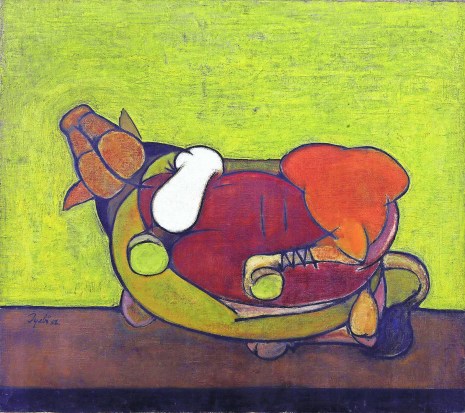
Late last month, all eyes were on New York’s Rockefeller Center when the hammer came down for Christie’s latest South Asian modern and contemporary art sale. The entire auction saw strong bidding, but what stole the show was an untitled work (Gram Yatra) by celebrated artist MF Husain that was sold for over Rs 118.7 crore (about $13.8 million)— becoming the most expensive modern Indian painting to be ever sold.

The painting was reportedly bought by renowned art collector and philanthropist Kiran Nadar. Incidentally, the sum paid for Gram Yatra (1954)—a mural-sized painting that spans almost 14 feet across 13 vignettes—is nearly double that of the previous record-holder, Amrita Sher-Gil’s The Story Teller (1937), which fetched about Rs 61.8 crore ($7.4 million) at a Saffronart auction in Mumbai in 2023.

Earlier this month, Amrita Sher-Gil’s The Story Teller was joined by Trussed Bull, an oil on canvas painted by Tyeb Mehta in 1956, which sold for the same amount (Rs 61.8 crore) at a SaffronArt auction.

The record-breaking sales are a watershed moment for Indian art, highlighting its growing value in the global market. Earlier in March, at a Sotheby’s auction in New York, a 1973 painting by Jagdish Swaminathan—Homage to Solzhenitsyn—sold for about Rs 40.1 crore ($4.69 million), far exceeding its $1 million low estimate.
All of this is happening at a time when the Indian art market is experiencing significant growth, as revealed by the 2024 Hurun India Art List, where sales by the top 50 artists reached a record-breaking $36.2 million (Rs 301 crore), a 19% increase from 2023, driven by India’s strong economy and rising disposable income.
Impressive though it may sound, Indian art is yet to take its rightful place on the international stage. A simple glance at the numbers will tell you why. Husain’s recent $13.8 million, for instance, pales in comparison to global contemporaries like Gustav Klimt’s Lady with a Fan that fetched $108.4 million at a Sotheby’s auction in 2023; Pablo Picasso’s Les femmes d’Alger, Version ‘O’ that was sold for $179.4 million at Christie’s in 2015, and Femme à la montre, his second highest sale, that was sold for $139.4 million at Sotheby’s in 2023.
Why India lags behind
As per art critic-curator and author Uma Nair, we need more originality and ingenuity. “Remember there is only one Pablo Picasso and one March Chagall. Masters don’t happen every year. We cannot become a generation that apes the West. Unfortunately, there is an overdrive of images on the internet and this has changed the sensibility of the present generation,” she adds.
“People need to understand art better,” feels Uday Jain, director of Dhoomimal Gallery in Delhi, which was established in 1936 and has exhibited works by well-known painters like Sailoz Mookherjea and Jamini Roy, and contemporary artists like MF Husain, J Swaminathan, and FN Souza.
“The more we expose Indian art to a global audience, we will see more awareness and rise in interest among people, and therefore sales will happen. Husain has been the most revered of all, and set a benchmark that was far-fetched for even dealers and auction officers, and could probably have been unachievable until the next five years,” he says.
As per Jain, the government or the culture ministry, the NGMAs, and the political academies need to play a more active role in popularising modern art. “Also, we should not wait for the West first to validate a work of art, and then start accepting it more here ,” adds Jain.

For Nishad Avari, head of department, Indian art at Christie’s, the Indian art market is much younger and more nascent than most others. “The first professional galleries in India date back to the 1950s and 60s, and standalone international auctions of South Asian modern and contemporary art only started being held in the mid-1990s. In most other categories, the primary and secondary markets were established much earlier, and as a result have had more time to develop and grow. However, as infrastructure in the primary market expands and a solid foundation is created, the Indian art market should continue on its current trajectory of growth and take its rightful place on the international stage,” says Avari.
Indrajit Chatterjee, founder, curator and director of Prinseps auction house, agrees. “We’re still in the early stages of the Indian market. For a country like India, $10 million for an artwork is nothing . But as the economy grows, this $10 million will easily become, maybe in the next 10 years, $100 million,” he says.
Indian art has to be ingrained in the social culture right from the start, feels Chatterjee. “In the West, people start collecting art by putting posters on their dormitory rooms. We don’t have that kind of culture here. Young collectors have to be encouraged at reasonable price points, so that they don’t think about it as an investment but as art for art’s sake,” he adds.
Changing landscape
Examples may be few and far between, but are nevertheless changing the landscape of the Indian art market globally. Take for instance, Sotheby’s recent modern and contemporary south Asian art auction, where Jagdish Swaminathan’s Homage to Solzhenitsyn was sold for $4.7 million. “Collectors were drawn to this masterpiece for its exceptional scale, rarity, rich aesthetic, and historical significance—factors that fuelled competitive bidding,” says Manjari Sihare Sutin, vice-president & specialist, co-worldwide head, modern and contemporary south Asian art, Sotheby’s.
Indian modern art is one of the most exciting and fast-growing art markets right now, says Sutin. “Our standalone auction in New York in March this year registered a total of $16.8 million aggregate against a pre-sale low estimate of $4.9 million. We are seeing this level of growth across auction houses and galleries, as well as in the expansion of art fairs and institutional efforts,” she adds.
“The South Asian modern art market is only getting started and we are excited by its potential across all price levels and regions of the world,” adds Sutin.

Today, art has gone beyond the conventional idea of value and perception. For instance, a yellow banana duct-taped to a wall by Italian artist Maurizio Cattelan became one of the most talked-about pieces in contemporary art, and sold for an astounding $6.2 million (Rs 52.35 crore) at a Sotheby’s auction. “Art is about creativity, and creation of a new language. An artist succeeds as he creates a language of his own and that can be recognised by other people. Taping the banana on the wall in that vein is an act of creativity. All these are successful experiments,” says Chatterjee, who has tokenised FN Souza’s artworks in digital format for art collectors.
Growing global interest
While Indian art deserves to take its rightful place on the international stage, global interest in modern and contemporary art from India and its wide diaspora has grown exponentially over the last decade. Avari of Christie’s says, “In the country, new galleries, museums, art fairs and biennales have added to an increasingly vibrant arts ecosystem, providing much needed opportunities for a young, expanding population to engage with modern and contemporary art. Internationally, several prominent galleries now represent artists from the region and notable museums around the world are presenting significant solo and survey shows of their work. If sustained, this growth is sure to put Indian art on track to achieve even greater heights and recognition in the near future.”
With art becoming more accessible to private collectors, and to flourish in India, museums like the Kiran Nadar Museum of Art (KNMA) are facilitating cross-cultural dialogue and expanding access to transformative artistic experiences. This is evident in its collaborations like the recent one with the Italian Cultural Centre to host the historic and revolutionary Baroque artwork titled Mary Magdalene in Ecstasy by Italian artist Caravaggio.
“The project offers a rare opportunity to our local audiences in particular, to view a Caravaggio painting, and encounter an artistic lineage that has fascinated generations of Indian artists. This arrival marks a significant moment in India’s engagement with classical European art, drawing our attention to painterly feats in easel painting in oil,” says Kiran Nadar, founder and chairperson, KNMA.
Nadar says this is just the beginning. “It is one glimpse of what art and culture lovers can expect in the future. By 2026, we are opening a landmark cultural destination with a new location, an expansive 100,000-square-metre architectural centre near the Indira Gandhi International Airport, New Delhi. The plan is to host more such masters, seminars, talks, art courses, workshops, opera, craft shows, making it a vibrant hub for visual and performing arts, fostering artistic innovation and cultural dialogue,” adds Nadar.
Online auctions and the accessible art market are also on a steady rise. Manoj Mansukhani, CMO, AstaGuru auction house, says, “Only in the past few decades has art come to be seen as a valuable aesthetic possession. Indian artists and their works are being recognised and exhibited globally, contributing to the country’s prominence in the international art arena.”
Among some of AstaGuru’s top records include Tyeb Mehta’s Diagonal (1973) that sold for Rs 25.29 crore in 2022; Manjit Bawa’s Untitled (Krishna) (1992), which fetched Rs 25.11 crore in 2023; and MF Husain’s Voices (1958), which realised Rs 18.47 crore in 2020. Jehangir Sabavala’s artwork fetched Rs 15.8 crore in 2024.

“Both Indian and non-Indian buyers show serious interest as they are keen on acquiring the best, and acknowledge value based on the importance of a painting,” says Dinesh Vazirani, CEO and co-founder of Saffronart, who feels art transactions now span multiple channels, with a strong shift towards online platforms, widely embraced by Indian buyers. “Traditional auctions have evolved into hybrid experiences with live streaming and online/ mobile bidding,” he adds.
If global recognition is fuelling Indian art, new art galleries such as Subcontinent, which opened its doors in Mumbai recently, is bringing shows of pioneering modernists like the renowned figurative painter and Padma Shri artist Haku Shah’s seven-decade-long practice. These are themes deeply embedded in South Asia’s cultural fabric. On the other hand, there is artist Arpita Singh, who in her six-decade long career, has for the first time exhibited outside India, at the prestigious Serpentine Gallery in London. It goes to show how Indian art is increasing global recognition and appreciation.
“South Asian art is experiencing a significant global moment, with major international institutions actively showcasing works by artists from the region. A prime example is celebrated artist Arpita Singh. This global recognition, combined with the flourishing art market, has had a profound impact domestically, providing both emerging and established artists—from prominent metropolitan hubs to smaller regional towns—with platforms to expand their reach,” says Jaya Asokan, director, India Art Fair. In its 16th edition this year, the art fair announced robust sales starting from Vadehra Art Gallery selling 90% of their booth on the first day, with prices ranging from $2,500 to $300,000 including works by Sudhir Patwardhan, Atul Dodiya, Shilpa Gupta, and Vivan Sundaram. On the first day, David Zwirner sold a painting by Portia Zvavahera, a painting by Oscar Murillo, a sculpture by Huma Bhabha, and a painting by Sosa Joseph with prices ranging from $12,000 to $450,000, and Carpenters Workshop Gallery made sales worth $600,000. Nature Morte sold 70% of their booth by the second day, including a Jitish Kallat for $100,000.
Rise of young collectors
Experts see a noticeable uptick in new collectors in their 30s, enthusiastic about building their collections and driven by rising incomes, exposure to global trends, and eager to explore art and collectibles.
“Young buyers are well-informed, conducting thorough research before purchasing art, which marks a significant shift from the past. This approach is a positive sign for market growth. Young professionals are becoming serious art collectors, often gravitating towards contemporary art that resonates with their personal tastes and values,” says Vazirani.
But art should not be collected as an investment, but as a testament to cultural and intellectual engagement, says Bhavna Kakar, founder and director, Latitude 28 gallery in New Delhi. “The rise of new artistic voices is crucial to the evolution of contemporary art, offering fresh perspectives that challenge and redefine existing narratives. Artist Sudipta Das’ works have been acquired by major museums in Europe and Asia, including the Kiran Nadar Museum of Art, while Waswo X Waswo has established a strong global presence with his nuanced explorations of identity and colonial histories. Australian painter Khadim Ali is currently exhibiting at the COMO Museum in Pakistan and Museum MACAN in Jakarta, and is preparing for a major project at the Bukhara Biennale in Uzbekistan,” she adds.










